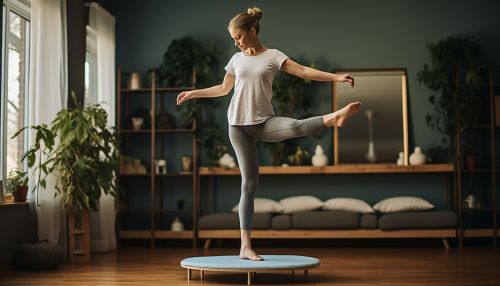Proprioception
Introduction
Proprioception is a complex sensory system that involves the perception of body movement and position. It is sometimes referred to as the "sixth sense," as it provides information about the relative positions of parts of the body and strength of effort being employed in movement. It is an essential aspect of motor control and postural control.


Anatomy and Physiology
The primary anatomical structures involved in proprioception are the proprioceptors, sensory receptors located in muscles, tendons, and joint capsules. These include muscle spindles, Golgi tendon organs, and Pacinian corpuscles. Muscle spindles are sensitive to changes in muscle length and rate of length change, Golgi tendon organs detect changes in muscle tension, and Pacinian corpuscles respond to pressure and vibration.
Proprioceptive information is transmitted to the central nervous system (CNS) via afferent pathways. The dorsal column-medial lemniscus pathway is the primary pathway for proprioceptive information from the lower body, while the spinocerebellar tract carries proprioceptive information from the upper body.
In the CNS, proprioceptive information is processed in several areas, including the cerebellum, basal ganglia, and somatosensory cortex. The cerebellum plays a crucial role in integrating proprioceptive information with motor commands to coordinate movement and maintain balance.
Role in Motor Control
Proprioception is fundamental to the process of motor control. It provides the CNS with real-time information about the position and movement of body parts, allowing for the coordination of movements and the maintenance of postural stability. Without accurate proprioceptive input, movements would be uncoordinated and clumsy.
Proprioceptive feedback is also essential for motor learning. By providing information about the outcome of motor commands, it allows for the refinement and adaptation of movements. This is particularly important in learning new motor skills, such as playing a musical instrument or participating in a sport.
Clinical Significance
Impairments in proprioception can have a significant impact on motor control and balance. Conditions such as peripheral neuropathy, stroke, Parkinson's disease, and Multiple sclerosis can all result in proprioceptive deficits. These can manifest as difficulties in coordinating movements, maintaining balance, or learning new motor skills.
Assessment of proprioception is an important part of neurological examination. This typically involves tests of joint position sense and movement sense. Rehabilitation strategies for proprioceptive deficits focus on improving awareness of body position and movement through exercises that challenge balance and coordination.
